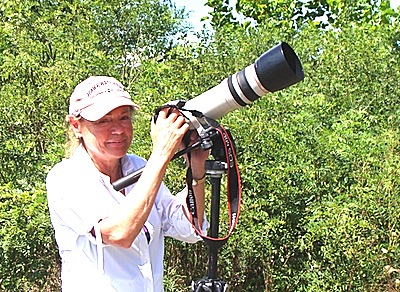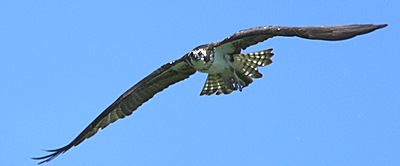- By Dan Veaner
- Around Town
 Print
Print  Much has been made of the osprey couple that took up residence on a nesting platform on Salt Point in Lansing last April. The pair hatched three chicks in June that today are about as big as their parents. A sixth family member has a nest nearby. She can't fly, but has been part of the ospreys' world since the first day the parents became interested in each other. Biologist Candace Cornell has been on the scene observing the birds nearly every day.
Much has been made of the osprey couple that took up residence on a nesting platform on Salt Point in Lansing last April. The pair hatched three chicks in June that today are about as big as their parents. A sixth family member has a nest nearby. She can't fly, but has been part of the ospreys' world since the first day the parents became interested in each other. Biologist Candace Cornell has been on the scene observing the birds nearly every day."I was struck the first time I saw them," she says. "I fell in love with them. I stood here and took 500 to 600 pictures for hours and hours. I started coming every day after that."
 Left to right: Stevie, Paulie and Robyn with their mother. Picture above: Stevie grown up. Photos by Candace Cornell
Left to right: Stevie, Paulie and Robyn with their mother. Picture above: Stevie grown up. Photos by Candace CornellCornell has only missed four days all summer. Every other day she sets up her 'office' on the lake side of the 65 foot tall utility pole with a nesting platform on top. It consists of a folding chair, a laptop computer, a beverage, binoculars, a strategically placed camera on a tripod and a scope she sets up so passers-by can get a closer look. She wears the same colored clothes every day so the birds will regard her as part of the landscape. On most days her husband brings dinner at the end of the day so they can watch the birds and the resplendent sunsets over Cayuga Lake.
Now retired from the Cornell Laboratory of Ornithology, Cornell is writing a book entitled 'On Osprey Time' chronicling the osprey family's first summer. Many things came together to make this summer a unique opportunity to get in on the ground floor. Last spring Lansing Park Superintendent Steve Colt approached NYSEG Forrester Paul Paradine about erecting a nesting platform on one of the old utility poles still on Salt Point. He wanted to make sure no power was being delivered before encouraging birds to nest there. Paradine did him one better -- he and his crew erected a pole that was optimized in height and location to attract osprey. Paradine's fiance Robyn Bailey, a biologist at the Cornell Lab of Ornithology, provided advice on how best to construct the nest, and the best location for a nest.
The pole went up in late March, and Paradine hoped it would attract an osprey pair, noting that there were no guarantees. Bailey, a fellow member of the Cayuga Bird Club, told Cornell about the nesting platform. She began observing on April 20th.
 Biologist Candace Cornell
Biologist Candace CornellA number of ospreys began fighting for the nest, and eventually one pair won. Two days after she began watching the birds, Cornell saw the beginning of what will be a lifelong romance.
"On April 22 they had their first 'date'. He gave her a stick and then he gave her a fish and that was it," she says. "They fell in love. And then they had to start building the nest and defending the nest. They're big, they're beautiful, and they do everything right out in the open. They don't mind us being voyeurs, and you can see everything they do."
Cornell says she observed the parents copulating 190 times in a three week period to produce three eggs, which were laid on May 6th, 9th and 12th. Like clockwork the chicks hatched on June 15, 18 and 21st. She named the oldest Robyn, the middle chick Paulie, and the youngest Stevie after Baily, Paradine, and Colt. Three chicks is a typical number for osprey, but Cornell says for a young pair in their first mating two would have been better.
"The survival of the chicks depends a lot on the experience of the adults and how capable they are of feeding them and caring for them," she says. "The fact that they could raise three chicks is amazing, and they are all as healthy as can be."
 The father osprey. Photo by Candace Cornell
The father osprey. Photo by Candace CornellNow they are big. You easily can see them without the aid of binoculars, but the view through Cornell's lens is spectacular, as if you are actually in the nest with them. At first it was easy to tell which was which because you could differentiate them by size. A few weeks ago they had grown to full size. Cornell must now observe their markings to tell who's who. When osprey are young they have dusky breasts that change to white. The females get a necklace of chocolate feathers around their necks. The males get a thinner 'chain' of chocolate, but not a big necklace.
Cornell can easily distinguish Robyn by her chocolate necklace, but it's harder to tell the boys apart visually. But the middle chick has made it simpler.
"Paulie is a bit of a klutz," Cornell laughs. "Let's put it this way: when he lands on those cross bars on the platform I can hear a thud. None of the other birds make a noise."
The way she describes them, the parents sound a lot like a human couple. She has watched them collect objects to decorate the nest, which can get up to 400 or more pounds. She spent a month cataloging the objects the birds brought into the nest and the ones female tossed out. She cleans up after the birds to keep the park litter-free.
"It can be hysterical what they put in the nest," Cornell says. "The female is totally into decorations. The male can go to all this trouble to get a stick and if she doesn't like it she just chucks it out. He might make ten attempts to get a mylar balloon that was stuck on a tree and finally get it to the nest. If she likes it, great. If not, over the side! And she changes her mind, too."
She says she observed the birds bringing twine or fishing line into the nest, which is often a hazard for chicks who may strangle in it. But she says these chicks are big enough now that it doesn't pose a danger, and after the season Paradine will return with his crew to clean out the nest.
Cornell spent her first six weeks recording a schedule of the birds' activities. She chronicled when every fish was delivered, its size, when they spit, when they scratched, how long they preened... everything they did. After recording their activity for six weeks she found they kept to a predictable schedule, but one that changed in the different stages of the chicks' development.
"They keep to a schedule more or less," she says. "They really do. But each time they move to a different stage of their breeding cycle everything changes."
After the first six weeks she started writing the book. But while working on that she knows when to expect specific activities, which helps her decide when to observe more closely.
Cornell says osprey mate for life and return to the same nest year after year over what may be a 25 year lifespan. Being a new couple, she says they are likely to return early next April, which will make it easier to defend the nest.
The last chick fledged on the August 13th. Soon the female adult will fly to Columbia, Brazil, or Venezuela. Meanwhile Robyn flew for the first time on August 11th, Paulie on the 12th, and Stevie on the 13th. They are now in the 'teenage' phase where they are learning to be independent, but still being fed by their parents. The three practice flying daily, calling out in their high pitched voices, staying mostly around the Salt Point area.
 Paulie with a fish. Photo by Candace Cornell
Paulie with a fish. Photo by Candace CornellEven after the mother leaves the father will stay to teach the chicks how to fish and other survival skills. Now ten weeks old, Robyn and Stevie are already learning these things, becoming more and more proficient and aggressive. Paulie remains a klutz. Earlier this week he was forced to fly around for hours with a fish that got stuck on his talons. Eventually his sister helped by pulling it off.
As each chick becomes proficient they will migrate south individually. In September or October when the last chick has gone the father will finally go south. They will spend the winter apart, then meet back at Salt Point around the same time each year. Cornell says the parents will likely return earlier in April next year because they haven't had much time together yet. Each year after that they will arrive around the same day. The chicks will also come back and see the nest already occupied, so they will look for their own mate and a nesting place nearby.
Cornell plans to keep coming until the birds migrate in late September or October, and she is already planning to come back next season. That will mean a repeat of this summer, coming day after day and watching hour after hour. The day is broken up by people walking their dogs (she keeps a stash of dog biscuits on hand), and joggers and hikers who frequent Salt Point. But it is mostly observing and recording, taking pictures and writing. That's a lot of sitting and watching, and you would think that observing osprey all day, seven days a week, would be boring.
Cornell says it is anything but boring because she is 'On Osprey Time'. That is the title of her book, a phrase she borrows from the Lab of Ornithology's osprey expert Dr. Alan Poole.
"I sit here all the time and it's like a zen-like exercise where by sitting still you see so much more than you would if you weren't," she says. "The more you look at one thing the more you see everything. I am constantly fascinated. Living on osprey time is an amazing gift. I have never felt so peaceful and so content and whole. The other part is all the amazing people I've met. I have made some friends for life this summer."
v9i32



